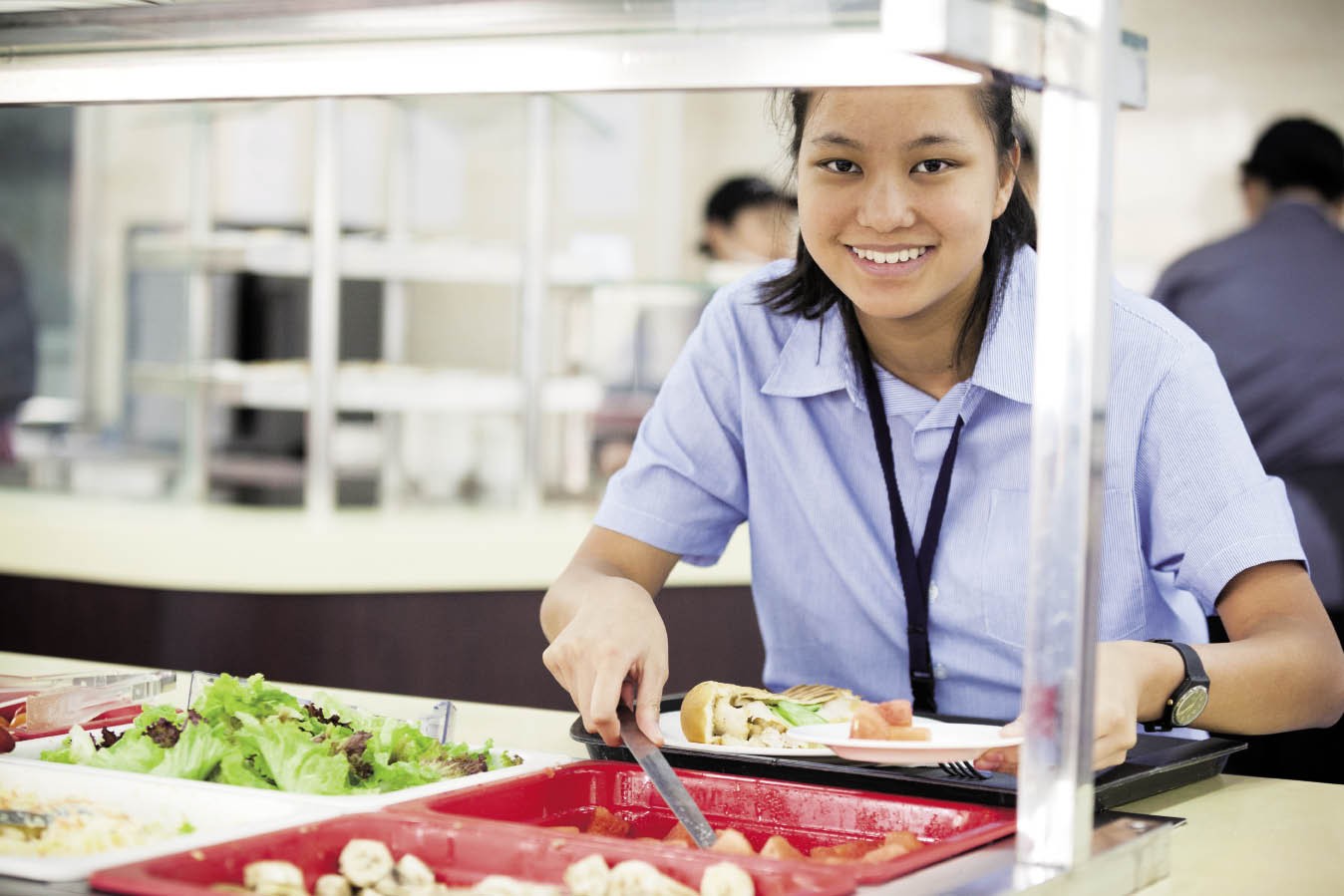
Do your kids get excited about the school cafeteria? Actually, that’s a silly question. Normally, the suggestion of a school cafeteria is enough to send anyone running for the hills. In fact, we’re more likely to associate school food with images of a sullen lunch lady plunking something colorless and jiggly onto a beige lunch tray rather than healthy or enjoyable meals. However, here in Shanghai our children are blessed with school cafeteria food that would make your mouth water. We spoke to both Shanghai Community International School (SCIS) and Yew Chung International School of Shanghai (YCIS) about what kind of food they serve and the importance of nutrition for growing kids.
Nutrition first

According to the World Food Programme (WFP), a daily meal at school is a direct route to better nutrition and health for kids, as well as increased access to educational success. It is also an incentive for many families to send children to school. In 2017, the WFP initiated or supported school meal programs in 71 countries and even directly provided meals to 18.3 million children in 60 countries. Working alongside over 60 governments, the WFP helped improve national school meal programs for 39 million children.
While we are lucky that the international school system in Shanghai is not in need of this type of nutritional assistance, the correlation of what children are served in their school cafeterias and the impact it has on their health and education should be emphasized.
My children attended Shanghai American School (SAS), Pudong and I remember the first time we entered the open, colorful and vibrant space. I had to ask myself if I was actually inside a school cafeteria. Over the years, I have had the privilege to visit a variety of international school cafeterias in Shanghai, all with a similar approach. Bright lighting, open floor plans, clean and orderly tables and seating as well as a happy buzz of students, teachers and staff enjoying their mid-day meals.
That’s not to say that it’s all good, all the time. As parents we see that some choices our kids make during the school day might not be the healthiest, especially if they are picky eaters or have food allergies and must eat a more restricted diet. Schools try to address these issues in a variety of ways. Many lunchrooms (and schools, in fact) are nut free. Menus are developed that support vegetarian diets and meals for those with specific food allergies. There can be as many as a hundred options for entrees and staple foods to choose from and some continually rotate with both International and Chinese dishes.
Lunchroom Logistics

We spoke with representatives from Shanghai Community International School (SCIS) to get more information about this important facet of the school day.
According to Stacey Poncia, Early Years Coordinator at SCIS, the process of developing a schoolwide meal requires a great deal of time, research, planning, and usually involves collaboration with an outside service. “We contract with a food services company to provide fresh, hot Western and Asian style meals daily for our school community. Each school campus has its own preparation kitchen, staffed by a trained chef and support staff.”
That’s right, some of these schools actually employ trained chefs. That’s not something one would expect or imagine at a school cafeteria, but as the program development consists of a team, it’s important to consult with professionals from start to finish.
Mariayk Leung, SCIS’s School Catering Representative explains, “A school representative collaborates with the catering representative to standardize the school lunch menu for all grades, including main courses (poultry, beef, fish or vegetarian), staple foods, vegetables, specialties, salad bar, sandwich bar, dairy and fruits.” There is also the involvement with certified nutritionists, whose knowledge can offer important information regarding the detailed components in all the foods served.
“Over the last five years, menus and recipes have been adjusted to increase the offering of whole grains, legumes, fresh fruits and vegetables with a reduction of fried and processed meats. The nutritional content is also reviewed to ensure that fat, sodium, cholesterol, and calories are at appropriate levels. A general guideline for the current menu is the Dietary Guidelines for Americans developed by the USDA (United States Department of Agriculture),” says Leung.
More than food

What children eat every day is significant. Nevertheless, it is important to note that good nutrition education actually happens before even stepping foot into the lunchroom. We interviewed several staff members at Yew Chung International School (YCIS), Pudong who offer insight into their holistic approach to nutrition outside of the cafeteria.
“It [nutrition] affects our day-to-day life. We try to encourage our students to think about making good decisions, rather than what is right or wrong. A piece of cake today is fine, but maybe not tomorrow, and sometimes a second helping is actually needed! They take this mindset home with them to continue making healthy choices,” says Matt Uffindall, Athletics Director at YCIS Pudong.
He goes on to say that “nutrition is vitally important to us all, so engaging youngsters’ thinking about it plays a big role in our lessons. Discussing food types, what a certain athlete might need or eat for a sport or an event, and thinking about how the sporting elite eat are all things that are brought into consideration.”
It’s understandable and reasonable that the Athletics Director would consider the balance between good nutrition and athletic performance, but what about other teachers and staff? How is it possible to integrate healthy eating into a classroom setting? Courtney Leedy, who is a Counselor and Student Wellbeing teacher at YCIS Pudong Secondary answers that question.
“In Student Wellbeing, we often discuss the importance of balance, healthy habits, positive body image, and physical and mental health. Nutrition plays a big part in all of these topics, including how to promote overall good health,” says Leedy.
Tracey Cooney, a Student Wellbeing & Physical Education (PE) teacher at YCIS Pudong Secondary, echoes the thought, “Nutrition is also incorporated into our Secondary Physical Education (PE) lessons, which focus on proteins, fats, carbohydrates, and the role they play in the body.”
With a curriculum that incorporates monthly ‘Learner Profile Traits’ that focus on balance, the school offers a variety of co-curricular activities after school that involve sports and areas of wellness. “Our Student Wellbeing program talks openly about diet and the need to eat well. Add to that science and other courses broaching the subject within their areas of specialty and we focus on nutrition across a number of disciplines,” says Uffindall.
These teachers take the role of nutritional education seriously, and find it a natural fit to combine theory with real life experience, inside the classroom and the cafeteria. “It’s important because nutrition affects all aspects of life. For example, healthy nutrition can contribute to improved concentration, healthy sleeping patterns, cell regeneration, positive body image, increased mental and emotional stability, and overall physical growth. Educating students on nutrition is more likely to promote lifelong healthy eating habits and health benefits,” explain Cooney and Leedy.
Healthy at home
Sharon Raccah, a certified health coach, could not agree more. Raccah is the owner of PowerMeHealthy and has lived in Shanghai for 15 years. A mother of three children, ages 12, 10 and 6, she knows firsthand the importance of providing nutritious, simple meals that kids want to eat. If children are particularly finicky or have severe allergies, it can be more beneficial to bring lunch from home, to ensure they are getting proper nutrition daily.
“Parents can start with giving (more) healthy options, such as veggies, fruit, hummus and avocado! Also it’s great to give them brown pasta with fresh tomato and grilled chicken. They can try home-made salsas, guacamole, tortillas, chickpeas… the options are endless!”
Realistically, we all know that what we ask kids to do and what they actually do are not always aligned. So, regardless of how good the intentions of our schools are, it’s important to keep in mind that kids will have access to junk food throughout the day. For this reason, it’s best to start the nutrition education at home.
Sharon offers some simple tips:
• Start at home, preparing favorite dishes together with fresh ingredients, so kids are aware of what goes into their bodies from the beginning.
• Consider ordering seasonal veggie/fruit boxes from places like Biofarm or Fields, which offer a variety of new and interesting options.
• Keep it simple by preparing recipes without high sodium, fat, and sugar, all of which can be controlled in your own kitchen.
So, while we can thank our lucky stars that the schools we send our kids to in Shanghai are passionate about health and nutrition, it’s also important to educate your kids at home so they can make the best health choices throughout the day and for the rest of their lives.
Good to Know
SCIS: https://www.scis-china.org
YCIS: https://www.ycis-sh.com
WFP: http://www1.wfp.org
Sharon Raccah:
http://www.powermehealthy.com